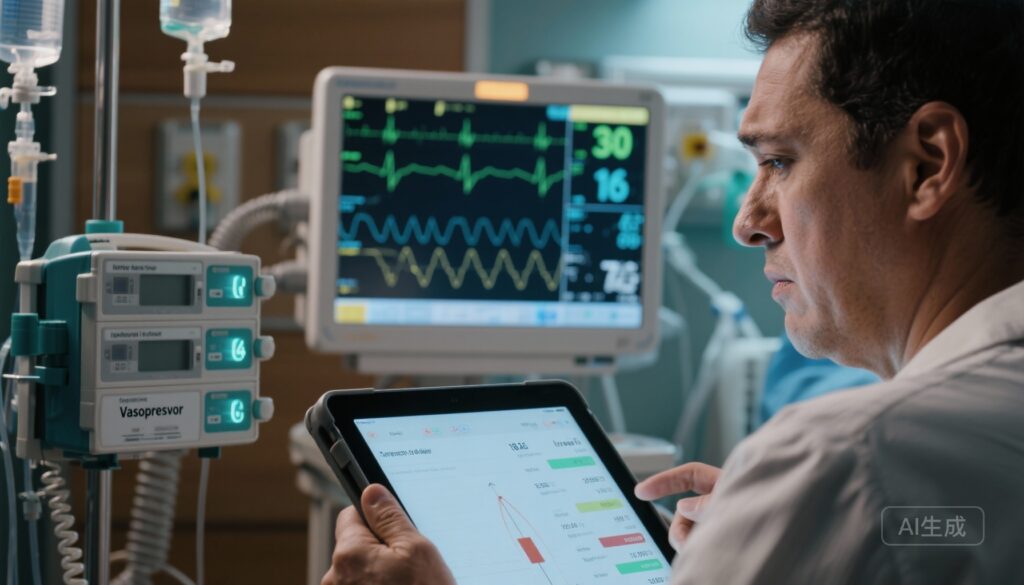Highlight
– A systematic review of randomized trials (McDonald et al., 2025) found no conclusive benefit of any specific vasopressor on incidence of acute kidney injury (AKI) in septic shock.
– Reporting was heterogeneous: only 8/17 trials reported AKI incidence using KDIGO/AKIN or undefined criteria; RRT use was the most common renal outcome but inconsistently defined.
– Existing evidence is underpowered and methodologically limited; future trials should standardize renal endpoints (KDIGO/MAKE), target subgroups at high renal risk, and include longer-term kidney outcomes.
Background: clinical context and unmet need
Septic shock is a leading cause of critical illness and of in-hospital acute kidney injury (AKI). AKI in sepsis increases short- and long-term morbidity and mortality and predisposes patients to chronic kidney disease (CKD) and dialysis dependence. Vasopressors are central to resuscitation when hypotension persists after fluid resuscitation; the choice and sequencing of agents modulate systemic and renal haemodynamics and, theoretically, may influence renal perfusion, urine output, and progression to RRT.
Clinical practice commonly uses norepinephrine as first-line vasopressor. Vasopressin (or its analogue terlipressin), angiotensin II and other agents are used as adjuncts to achieve target mean arterial pressure (MAP) or to reduce catecholamine exposure. Whether one vasopressor strategy confers protection against AKI or reduces the need for RRT has been a topic of randomized trials and debate—but renal endpoints have frequently been secondary, inconsistently reported, and variably defined.
Study design: scope of the systematic review
McDonald and colleagues prospectively registered a systematic review (PROSPERO CRD42023481778) and searched MEDLINE, Embase, Cochrane Central, conference abstracts and trial registries for non‑crossover randomized controlled trials comparing individual or combinations of vasopressors (or placebo) in adult septic shock and reporting renal outcomes. The primary outcome was AKI incidence; secondary outcomes included AKI duration, RRT initiation and duration, renal failure–free days, long-term RRT dependence, and Major Adverse Kidney Events (MAKE) at 30 and 90 days.
Seventeen randomized trials enrolling 4,259 patients were included. Vasopressin and terlipressin trials predominated; other vasopressors such as angiotensin II were less represented in the trial set. Reported baseline characteristics across reported trials reflected moderate-to-severe critical illness (mean age ~60 years, lactate ~3.3 mmol/L, SOFA ~10, APACHE II ~25 in the subset reporting AKI data).
Key findings
Primary outcome: AKI incidence
Only 8 of the 17 trials (47%) reported AKI incidence using KDIGO, AKIN or an undefined classification (the latter were relatively recent and therefore included in pooled consideration). These 8 trials represented 1,345 patients for whom AKI data could be assessed, though two trials lacked granular numeric AKI rates and could not be fully included in quantitative synthesis. When the less-informative trials were excluded, the AKI incidence in the remaining population was approximately 42%—likely an underestimate because several trials only reported more severe AKI stages (for example, AKIN stage 3) rather than all stages.
Across included trials, no consistent effect of vasopressor choice on AKI incidence was observed. Large terlipressin trials reported no demonstrated reduction in AKI or RRT with terlipressin compared with norepinephrine; however, numerical AKI rates were not always presented, limiting interpretability.
Secondary outcomes: RRT and other kidney-relevant endpoints
RRT initiation was the most commonly reported renal secondary outcome. Of the five trials that specifically interrogated vasopressin, a single study reported a statistically significant reduction in RRT use; the remaining trials showed no clear signal. Duration of RRT, renal failure–free days, and long-term RRT dependence were rarely or never reported. No studies reported MAKE30 or MAKE90—composite outcomes increasingly used to capture patient-centered kidney endpoints (death, new RRT, persistent renal dysfunction).
Safety
Safety profiles reflected known drug classes: vasopressin/terlipressin were associated with peripheral ischemic risks and potential digital ischemia in higher doses; catecholamine-sparing effects were observed but without consistent renal benefit. Trials were not consistently powered to detect differences in adverse renal events or non-renal harms.
Methodological limitations highlighted by the review
McDonald et al. emphasize several important limitations that constrain inference:
- Heterogeneous and inconsistent renal outcome definitions. Only a minority used KDIGO and some trials reported only advanced AKI (stage 3) or broad terms like ‘acute renal failure’.
- Inadequate granularity in reporting (e.g., lack of arm-specific AKI rates in large trials), preventing pooled quantitative meta-analysis in some instances.
- Underpowered studies for renal endpoints. Most trials prioritized mortality or hemodynamic outcomes and were not sized to detect realistic differences in AKI or RRT rates.
- Reliance on RRT as a surrogate for severe AKI. RRT initiation varies by practice patterns and clinician thresholds and is not a standardized physiological endpoint.
- Clinical heterogeneity across trials in inclusion criteria, vasopressor dosing strategies, timing of initiation, concomitant care (fluid strategy, steroid use), and baseline renal risk.
Mechanistic considerations
Biological plausibility for vasopressor-specific renal effects exists but is complex. Norepinephrine increases systemic vascular resistance primarily via alpha-1 stimulation, improving MAP and potentially renal perfusion pressure, but high-dose catecholamines may increase renal vascular resistance. Vasopressin (V1 receptor agonist) produces systemic vasoconstriction and may preferentially constrict efferent arterioles, potentially supporting glomerular filtration pressure in some settings and reducing catecholamine exposure. Terlipressin is a longer-acting V1 agonist with similar theoretical benefits. Angiotensin II (approved for vasodilatory shock) raises efferent arteriolar tone via the renin-angiotensin system and might favorably affect GFR. However, net renal effects depend on systemic haemodynamics, microcirculation, regional blood flow distribution, and timing—factors not standardized across trials.
Expert commentary and guideline context
Major guidelines (Surviving Sepsis Campaign) continue to recommend norepinephrine as the first-line vasopressor, with vasopressin suggested as an adjunct to decrease norepinephrine dose or to raise MAP when needed. Current guideline recommendations reflect mortality and haemodynamic data rather than conclusive renal protection.
Experts agree that renal outcomes have been inadequately prioritized and defined in vasopressor trials. The McDonald review reinforces calls from nephrology and critical care communities to standardize AKI reporting (use KDIGO criteria), adopt composite outcomes like MAKE30/90, and include long-term kidney endpoints and patient-centered outcomes in trial design.
Implications for clinicians
At present, choice of vasopressor should be guided by established guidelines and individualized haemodynamics rather than an expectation of renoprotection. Key practical points:
- Target adequate MAP individualized to the patient (often ≥65 mmHg, higher in chronic hypertension) to prevent hypotension-associated AKI.
- Use norepinephrine as first-line agent; consider vasopressin as adjunct to achieve MAP or reduce catecholamine exposure, not primarily to prevent AKI.
- Avoid delays in restoration of perfusion pressure; early vasopressor use when indicated may be kidney-protective by preventing prolonged hypotension.
- Monitor renal function closely; use KDIGO staging and urine output criteria to detect early AKI and to standardize communication and escalation of care.
Recommendations for future research
McDonald et al. propose a research agenda to resolve remaining uncertainties:
- Standardize renal outcome definitions (KDIGO for AKI staging; MAKE30/90 as composite endpoints) and report all AKI stages and absolute rates by arm.
- Design adequately powered randomized trials with renal outcomes as primary or co-primary endpoints, especially in populations at high renal risk (pre-existing CKD, elevated baseline creatinine, high vasopressor requirement, hepatorenal patients).
- Include longer-term kidney outcomes (90-day and 6–12 month RRT dependence, eGFR trajectory) and patient-centered outcomes (quality of life, functional status).
- Incorporate mechanistic substudies (renal biomarkers such as NGAL, TIMP-2·IGFBP7, microcirculatory assessment) to link haemodynamic changes to kidney injury biology.
- Evaluate emerging agents (e.g., angiotensin II) and stratify by timing of initiation and dose strategies; consider adaptive designs to detect subgroup effects.
Conclusion
The systematic review by McDonald et al. (2025) is the first focused synthesis of randomized evidence on vasopressor choice and renal outcomes in septic shock. It finds no consistent renoprotective signal for any vasopressor. However, heterogeneity in definitions, under-reporting of kidney outcomes, and inadequate power limit firm conclusions. Clinicians should continue to follow guideline-directed vasopressor selection and focus on timely restoration of perfusion pressure and kidney-protective supportive care. Future trials must standardize renal endpoints, power for kidney outcomes, and measure long-term kidney recovery to determine whether any vasopressor strategy can meaningfully change the trajectory of sepsis-associated AKI.
Funding and clinicaltrials.gov
The systematic review was prospectively registered on PROSPERO (CRD42023481778). Individual trials included in the review had variable funding sources; readers should consult original trial publications for trial-level funding declarations and clinicaltrials.gov entries.
References
1. McDonald R, Burns M, Wong A, Smith C, Ostermann M, Hutchings S. The effects of vasopressor choice on renal outcomes in septic shock: a systematic review of randomised trials as a guide for future research. Crit Care. 2025 Oct 2;29(1):417. doi: 10.1186/s13054-025-05573-7. PMID: 41039619; PMCID: PMC12492594.
2. Kidney Disease: Improving Global Outcomes (KDIGO) Acute Kidney Injury Work Group. KDIGO Clinical Practice Guideline for Acute Kidney Injury. Kidney Int Suppl. 2012;2(1):1–138.
3. Evans L, Rhodes A, Alhazzani W, et al.; Surviving Sepsis Campaign Guidelines Committee. Surviving Sepsis Campaign: International Guidelines for Management of Sepsis and Septic Shock 2021. Intensive Care Med. 2021 Mar;47(11):1181–1247.
4. Russell JA, Walley KR, Singer J, et al. Vasopressin versus norepinephrine infusion in patients with septic shock. N Engl J Med. 2008 Oct;358(9):877–887.
5. Khanna A, English SW, Wang XS, et al. Angiotensin II for the Treatment of Vasodilatory Shock. N Engl J Med. 2017;377(5):419–430.
Note: Additional trial-level details and individual trial citations are cited within the McDonald et al. systematic review and should be consulted for trial-specific outcomes and methodology.



